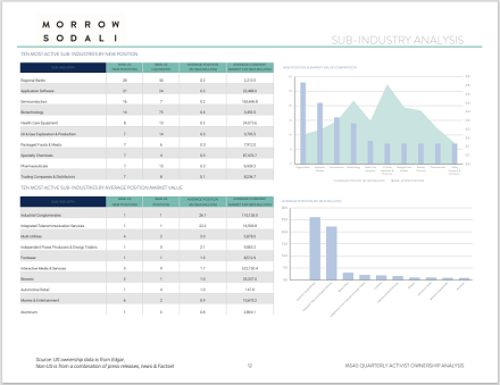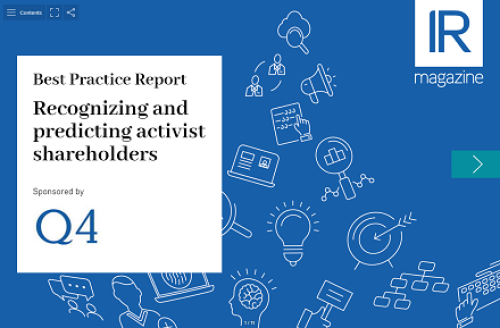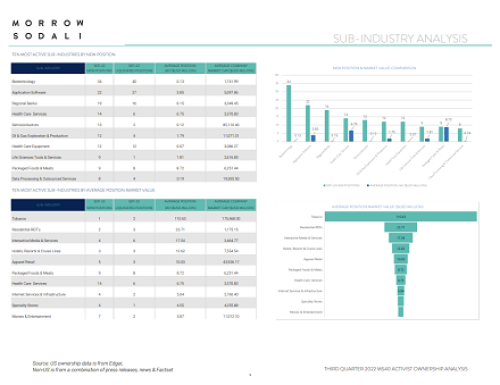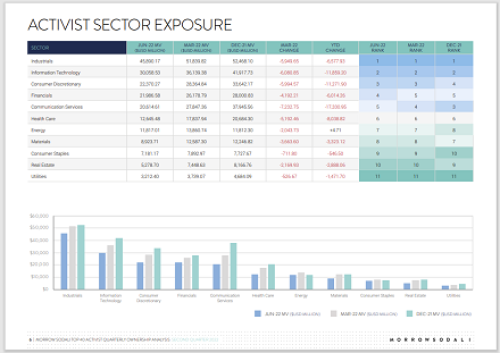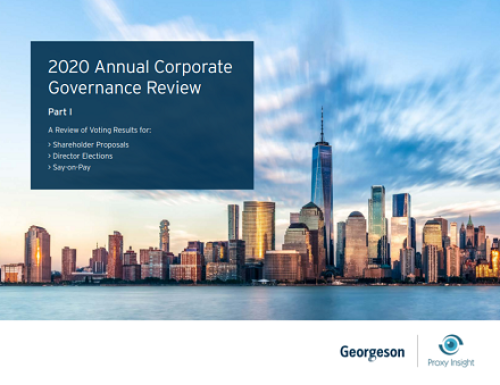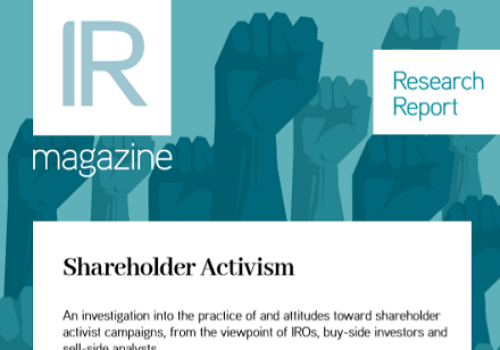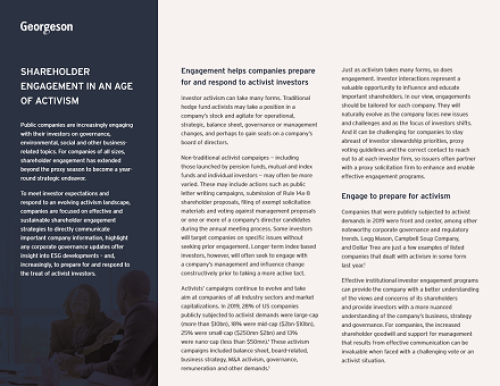Boardrooms across the country are increasingly discussing human capital management issues, as investors bring subjects like diversity and inclusion, employee safety, retention and engagement into focus. With so many CEOs of US companies signing the Business Roundtable statement on stakeholder value, and Covid-19 raising legitimate concerns about employee safety, companies can expect greater scrutiny of how they treat their employees in the future.
The majority of shareholder proposals on human capital management have asked for more detailed disclosures from companies. At Alphabet, Amazon and Walmart, meanwhile, employee groups have cosponsored shareholder proposals that made it to the ballot during the last couple of years. In each instance, existing employee-activist groups decided a shareholder proposal was an appropriate escalation of their lobbying of management.
At Amazon, employees filed a shareholder proposal in late 2018 asking management to publish a detailed description of how it intends to address climate change, in what is believed to be the first ever employee-led shareholder proposal at a technology company.
Alphabet, meanwhile, has had employee-related shareholder proposals for two consecutive years. In 2018 the company faced a proposal brought by Zevin Asset Management, and endorsed by an employee group, asking for a link between executive compensation and diversity and inclusion goals. The following year, the company faced a proposal asking for employee representation on the board. In its proxy statement, Alphabet outlined its process for selecting board directors, including a requirement for directors to have served as a public company CEO or CFO.
Employee representation in the boardroom is an issue Walmart has also had to address. At the 2019 annual shareholder meeting, Bernie Sanders presented a shareholder proposal requesting employee representation. This year the company faced a similar proposal, this time filed with the SEC, suggesting that management did not move quickly enough to address employee safety in light of the Covid-19 outbreak. The proposal did not make it to the ballot. Alphabet, Amazon and Walmart did not respond to requests for comment for this article.
Facing an employee-backed or employee-led shareholder proposal generates media attention and causes embarrassment for senior management. But are these recent examples a flash in the pan, or should more companies be bracing for employee-shareholder activism?
A confluence of circumstances
Pat Tomaino is director of socially responsible investing at Zevin Asset Management and has filed shareholder proposals at Alphabet and Amazon, as well as other large technology companies, in recent years. He worked with an employee group at Alphabet, following a mass employee walkout at Google in 2018.
‘It’s a strategy that we as impact investors want to leverage more in the future, but it really depends on a confluence of circumstances,’ he says. ‘We’re not in the business of instigating employee activity inside companies – that’s not the role of investors. We have a stake in the financial outlook of the company. We’re not creating employee activism but, where we do see that it exists, we take that into account. What are employees asking for and why are they acting that way? What signal should we take for how companies are handling their long-term ESG goals?’
Tomaino says that when he has talked to employee groups at large technology companies about shareholder proposals, there’s a feeling that they have tried other avenues of feedback and activism internally. ‘These employees had tried the usual channels and were looking for levers to make change,’ he says. ‘They’d done direct action, they’d talked to the press and they'd noticed that there’s power through shareholder proposals.’
In Germany, employee-shareholder activism is much more established. Labor groups have experimented with shareholder proposals since the early 1990s, according to an academic report from Natascha van der Zwan, assistant professor of public administration at Leiden University. One particularly notable example she highlights is the Deutsche Telecom annual meeting in 2007, when around 1,000 employees entered the meeting to voice discontent about increased working hours and pay cuts as part of a corporate restructuring. Employee-shareholders reportedly signed their voting rights over to local labor unions to oppose the restructuring, as part of a broader campaign involving employee walkouts and labor union protests.
For board directors in the US, Gillian Emmett Moldowan, partner at Shearman & Sterling, says it’s never been more important to receive meaningful updates about nonexecutive employees.
‘Employee campaigns of any nature get significant press attention,’ she explains. ‘Boards have historically been more separated from non-executive employee issues, whether it’s compensation or workers’ issues, or how employees feel about the firm as a whole. I would encourage boards to get an understanding from those who report into the board of human capital management risk and enterprise risks, as well as an understanding of what the company is doing to assess and mitigate those risks.
'If boards have not historically received information about employee satisfaction and employee sentiment about the company management, then getting hold of that information is a good first step.’
Structural issues
Instances of recent employee shareholder activism have defining traits that may not be replicated elsewhere. For instance, Tomaino explains that many Alphabet employees involved in the shareholder action feel aggrieved at how they think the company’s mission has changed. Google’s motto in its IPO documents was ‘Don’t be evil’, but it has since dropped the slogan and employees have expressed concerns about the direction the company is moving, including in its bidding for national defense contracts.
Aalap Shah, managing director at Pearl Meyer, highlights several structural issues that may make companies more at risk of employee shareholder activism in the future.
‘Part of the issue is the power some companies have given to their employees through equity,’ he explains. ‘In addition, many of these companies are recruiting from the same talent pool, where there’s a desire to work for a company that has some sort of positive purpose. There is significantly more desire [on the part of] millennials and Gen Z to be part of an organization that has purpose, and you’re going to have to compete for that top talent by giving them equity.’
Tomaino says employees with large amounts of their personal net worth tied up in company stock will view themselves as engaged investors as much as employees. But Moldowan says this shouldn’t make companies think differently about granting stock options to employees as part of their compensation packages.
‘Shareholders can bring a proposal if they qualify to do so under the proxy rules, and those shares can be bought on the market – they need not come from an equity compensation plan,’ she says. ‘Not giving equity awards won’t stop an employee acquiring equity by other means.’
An Amazon employee group recently filed a comment letter with the SEC expressing concerns and opposition to proposed changes to Rule 14a-8, on the grounds that planned shifts to share ownership and proposal resubmission thresholds would make it harder for employee groups to advocate for change.
All of the interviewees for this article agree that it’s important for boards to receive information about employee sentiment and for boards or management to be seen to respond appropriately when employee groups express significant levels of discontent. Tomaino acknowledges that it’s unlikely large passive investors would vote in favor of employees and against management – unless the proposal was on something truly egregious – but that a proposal can help cause embarrassment for management that may drive change.
As Covid-19 shines a greater light on the treatment and recognition of employees, and the Business Roundtable’s statement equally prompts stakeholders to question companies when they feel they’re not being given a fair hearing, this may not be the last we see of employee participation in shareholder proposals in the US.
This article originally appeared in the Summer 2020 issue of Corporate Secretary


